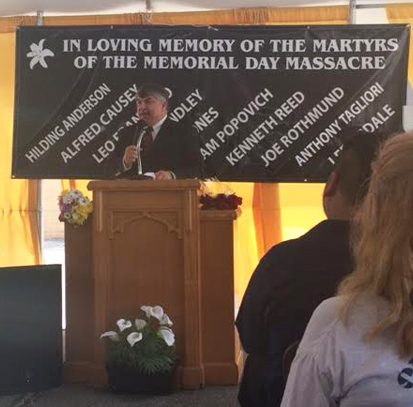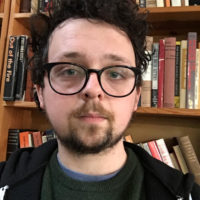
CHICAGO – Members of the United Steel Workers, past and present, as well as community gathered on Chicago’s South East Side to remember the lives lost and the lessons learned in the Memorial Day Massacre of 1937.
After forcing U.S. Steel to sign a labor contract, the Steel Workers Organizing Committee of the C.I.O. faced continued obstinacy from smaller firms including Republic Steel. In 1937 it came to a head with the “Little Steel Strike.”
On Memorial Day, workers and supporters gathered at Sam’s Place, now the church where the commemorators gather, and marched to the gates of Republic Steel. They were met, like many protests today are met, with a heavily armed police barricade.
As the protestors asserted their rights to protest, police grew increasingly agitated and soon began beating and opening fire on the aggrieved workers. In all, 10 were killed and over 60 seriously injured.
The memorial opened with an invocation and ceremonial reading of the names of the slain, including a 17-year-old boy who died of a gunshot wound to the back. Ten veiled members of United Steelworkers’ Women of Steel group draped their veils around 10 small white crosses as the names were read and a bell was rung. Somber bagpipes bookended the observance.
No sooner than the meditation on the lives of these workers ended did the analysis of the worker’s current conditions and future prospects begin.
Ebony Parker of USW Local 7-1 and member of the USW women’s group, “Women of Steel,” was one of the leaders in the oil workers strike from BP Whiting, an oil refinery in nearby Indiana.
“When I began to do the research about the 1937 Republic Steel Massacre, it was at that point that I realized how far we’ve truly come,” Parker said.
Another Woman of Steel, Jessica El-Samad, second generation steel worker and member of USW Local 10-10 said, “I am proud to represent the many members of USW, but I am even more proud to pay respect to those who perished in the Memorial Day massacre in 1937. The men and women who we speak of today fought the battle that we continue to fight today and into the future.”
The future for the USW appeared bright as the focus shifted to the youth in attendance. USW Next Generation is a program designed to inspire the young members of the USW and seeks to introduce young people to a life of activism.
Two high school students from nearby George Washington High School were honored for essays they wrote comparing the struggle of workers against Republic Steel to the struggle of the Chicago Teachers Union in 2012. Additionally, young Justin Willis of Next Generation presented AFL-CIO President and keynote speaker of the event Richard Trumka the “Kicking Ass for the Working Class” award.
According to Scott Marshall, leader of his district’s chapter of Steelworkers Organization of Active Retirees (SOAR), participation in the community and among the workers has grown every year. This year marked a milestone, as it was the first time that the keynote speaker of the event was a member of the top leadership of the National AFL-CIO.
President Richard Trumka took the stage to thunderous applause and put a point on the memorial. “I don’t know if we can do justice to the memory of the events because to treat them honestly is to describe truly, truly horrific actions,” he said. “Yet, this massacre happened in the light of day and went unpunished.”
“Quite frankly, the massacre happened because of the power of money to corrupt democracy and overpower the bill of rights.”
He tied the corrupting influence of the rich to economic and political relations today, citing the unfathomable wealth of the Walton’s and corporate CEO’s and their abilities to flout the law.
“Corporate presidents and managers all over this country continue to violate that same federal law: the Wagner act, which has the job of encouraging unionism in America… its corruption when the power of money overcomes federal law like last year in Tennessee when a sitting Governor and a Senator campaigned with threats and intimidation against workers at a Volkswagen plant in Memphis. That’s not the exception in America, that happens every day.”
With regard to the brutality of the events themselves, the lawlessness of state actors, Trumka went as far as to invoke the specter of recent police murders in Ferguson and Baltimore. The Memorial Day massacre was filmed on a newsreel that was suppressed for years following the events. It showed the truth of the event, like the cell phone cameras employed in the streets today.
“See the authorities lied about the massacre to protect the police and the managers of Republic Steel who had amassed an arsenal of weapons to fight the workers efforts to form a union, and because of those lies and because the newsreel was kept from the public, the newspapers said the police had beaten back a mob. Yet, the truth wasn’t forgotten and the massacre simply didn’t wash away.”
After the long list of speakers including Mayoral candidate Jesus “Chuy” Garcia gave their respects, the crowd of about 200 were led across the street to a memorial by Rev. Len Dubi who gave the benediction and closed the event.
“Our slogan for some time for the event has been ‘They fought then, we fight now!’ We remind ourselves and others that the labor movement has many times had to fight for it’s very existence and that is true for today – so we remember to help build the fighting spirit for today” concluded Scott Marshall.
Photo: Patrick Foote/PW









